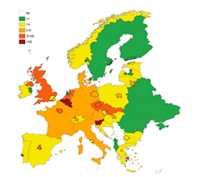Advertisement
Grab your lab coat. Let's get started
Welcome!
Welcome!
Create an account below to get 6 C&EN articles per month, receive newsletters and more - all free.
It seems this is your first time logging in online. Please enter the following information to continue.
As an ACS member you automatically get access to this site. All we need is few more details to create your reading experience.
Not you? Sign in with a different account.
Not you? Sign in with a different account.
ERROR 1
ERROR 1
ERROR 2
ERROR 2
ERROR 2
ERROR 2
ERROR 2
Password and Confirm password must match.
If you have an ACS member number, please enter it here so we can link this account to your membership. (optional)
ERROR 2
ACS values your privacy. By submitting your information, you are gaining access to C&EN and subscribing to our weekly newsletter. We use the information you provide to make your reading experience better, and we will never sell your data to third party members.
Environment
Nitrogen Levels Drop In Groundwater
Agricultural Pollution: Regulations can reduce nitrogen pollution, according to a new survey in Denmark
by Naomi Lubick
December 8, 2010

Animal farms and fertilizers add huge amounts of nitrogen pollution to the environment across the developed world. But regulations on agricultural use and disposal of the vital nutrient in Denmark may have successfully curbed nitrogen in groundwater, according to new research published in Environmental Science & Technology (DOI: 10.1021/es102334u).
Excess nitrogen has caused environmental problems such as dead zones in the Chesapeake Bay and Gulf of Mexico estuaries. Groundwater, which is recharged by rainfall and water flowing over the Earth's surface, also carries nitrogen pollution. Since groundwater is a source of drinking water, such pollution also causes concern about human health because of its potential to form carcinogenic compounds called nitrosamines.
In Europe, countries must monitor their nitrogen levels and aim for strict limits set by the European Union Water Framework and Nitrates Directives. To meet these directives' goals, Denmark established a monitoring program 20 years ago. Now researchers from the Geological Survey of Denmark and Greenland and from Aarhus University have put its groundwater data to use.
They started by using the groundwater's levels of chlorofluorocarbons (CFCs) to estimate the date when each pocket of water sampled seeped into underground rocks: because atmospheric CFC levels have changed over time in a known pattern, the researchers could determine the age of each water sample. The researchers then measured nitrate concentrations in the samples and used those findings to estimate how much nitrogen trickled into groundwater from agricultural use over the past 60 years. The nitrogen inputs to groundwater increased between 1950 and 1981, rising from 60 to 180 kg of nitrogen per hectare. Concentrations stagnated until 1995, when levels started to drop. By 2007, the average nitrogen inputs dipped to 117 kg per hectare.
Lead author Birgitte Hansen, a senior scientist at the geological survey, comments that Danish government initiatives enacted in 1985, including limits on how much nitrogen farmers can apply to different crops, seem to have worked. Despite decades-long growth in Denmark's milk and pork production, accompanied by the increases in nitrogen use, less of the nutrient has found its way into groundwater. Hansen speculates that decreases in nitrogen that the team reported to have occurred before 1985 could have stemmed from widespread changes in agricultural practice like reducing the runoff from manure heaps or livestock sheds.
But the improvements in groundwater are only part of the pollution picture, Hansen cautions. Denmark continues to face nitrogen pollution from agricultural runoff at its shores, she notes, particularly on the Baltic Sea.
The results are still "good news," says Karen Burow, a hydrologist at the U.S. Geological Survey, based in Sacramento, Calif. She says that the changes in groundwater quality show that "you can make a difference in a short time."
However, similar regulations may have different effects in other aquifers, Burow says. Depending on the geologic setting, including the rock type and how much rainfall replenishes the aquifer, she says, cuts in agricultural nitrogen use could take "quite a long time" to influence groundwater pollution levels.




Join the conversation
Contact the reporter
Submit a Letter to the Editor for publication
Engage with us on Twitter